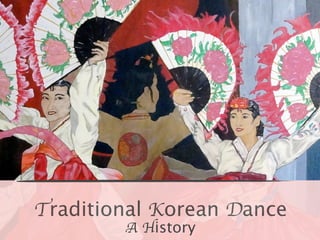Korean dance
- 1. Traditional Korean Dance A History
- 2. History of Korean Dance Pre-historic Times Ancient Era Three Kingdoms Period Koryo Dynasty Joseon Dynasty Modern Times
- 3. Prehistory Hunting Dances Rites of Passage Dance Danced while Festivals holding everyday items Harvest work tools Battle Dances weapons Magical Healing
- 4. Ancient Times Kingdom of Farming Dances Gojoseon (2000 Bce) Rites to Heaven Bronze culture- agriculturally Funeral Dances based Magical Healing
- 5. Three Kingdoms Period Goguryeo Buddhism Arts & Baekje CUlturE Silla
- 6. Goguryeo Dance Chinese Cultural Funeral In’¼éuence Associated dances linked to culture Evidence for of Tibet, nepal, Dance comes from himalayas tomb murals Buddhism & Acrobatic Taoism & traditions of Shamanism North
- 7. Baekje Dance Maritime Culture - Exchange with China Farming Culture Culture transmission to Japan Mask Dances
- 8. Silla Dance Uni’¼üed Silla Pre uni’¼üed Silla Dances More diverse Types of dances evidence in to-u ’¼ügurines Sword dances, Mask Dances Court dances Dance still based on accompaniment all aspects of life
- 9. Koryo Dynasty Dance Elaborate dances for all occasions HIgh Buddhism in’¼éuence ritual and music important Kings actions immortalized in the arts music and dance at festivals seasonal customs
- 10. Joseon Dynasty Dance Buddhism and Shamanism suppressed Confucian court dances less frivolous more slow and digni’¼üed
- 11. Korean Dance Today Upholding Korean cultural heritage Performed by artists who are studied in the proper forms Danced by common people
- 12. Characteristics of Korean Dance Ritualistic In’¼éuence from Buddhism, Taoism, Hanbok attire Shamanism long sleeves, fans, Based on all aspects swords, masks of Life integral parts of dance Very detailed, speci’¼üc Meticulous steps, hand movements, Have been well ’¼éowing arms preserved
- 13. Types of Korean Dance Court Dance FOlk DAnce Many Styles of Ritual Dance dance Professional Mask, sword, Entertainers drums, COmmon People exorcism, etc... DAnce
- 15. ņé┤ĒÆĆņØ┤
- 16. ņŖ╣ļ¼┤
- 18. ŪĻÖņČż
- 19. ņ▓śņÜ®ļ¼┤
- 21. Ļ▓Č─ļ¼┤
- 22. The End - ENjoy The Videos
Editor's Notes
- \n
- \n
- \n
- \n
- \n
- \n
- \n
- \n
- \n
- \n
- \n
- \n
- \n
- \n
- \n
- \n
- \n
- \n
- \n
- \n
- \n
- \n





















